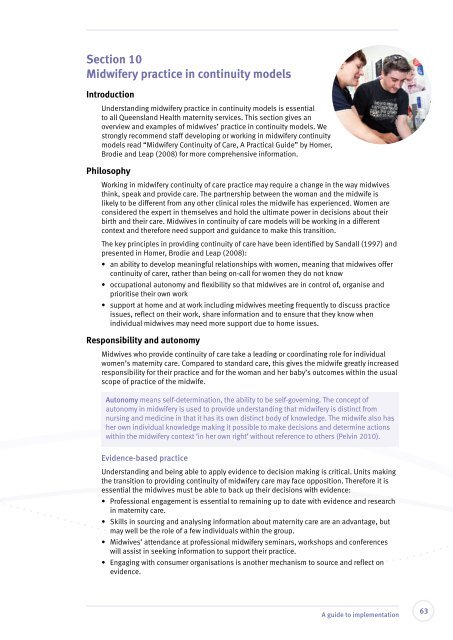Delivering continuity of midwifery care to Queensland women
Delivering continuity of midwifery care to Queensland women
Delivering continuity of midwifery care to Queensland women
You also want an ePaper? Increase the reach of your titles
YUMPU automatically turns print PDFs into web optimized ePapers that Google loves.
Section 10<br />
Midwifery practice in <strong>continuity</strong> models<br />
Introduction<br />
Understanding <strong>midwifery</strong> practice in <strong>continuity</strong> models is essential<br />
<strong>to</strong> all <strong>Queensland</strong> Health maternity services. This section gives an<br />
overview and examples <strong>of</strong> midwives’ practice in <strong>continuity</strong> models. We<br />
strongly recommend staff developing or working in <strong>midwifery</strong> <strong>continuity</strong><br />
models read “Midwifery Continuity <strong>of</strong> Care, A Practical Guide” by Homer,<br />
Brodie and Leap (2008) for more comprehensive information.<br />
Philosophy<br />
Working in <strong>midwifery</strong> <strong>continuity</strong> <strong>of</strong> <strong>care</strong> practice may require a change in the way midwives<br />
think, speak and provide <strong>care</strong>. The partnership between the woman and the midwife is<br />
likely <strong>to</strong> be different from any other clinical roles the midwife has experienced. Women are<br />
considered the expert in themselves and hold the ultimate power in decisions about their<br />
birth and their <strong>care</strong>. Midwives in <strong>continuity</strong> <strong>of</strong> <strong>care</strong> models will be working in a different<br />
context and therefore need support and guidance <strong>to</strong> make this transition.<br />
The key principles in providing <strong>continuity</strong> <strong>of</strong> <strong>care</strong> have been identified by Sandall (1997) and<br />
presented in Homer, Brodie and Leap (2008):<br />
• an ability <strong>to</strong> develop meaningful relationships with <strong>women</strong>, meaning that midwives <strong>of</strong>fer<br />
<strong>continuity</strong> <strong>of</strong> <strong>care</strong>r, rather than being on-call for <strong>women</strong> they do not know<br />
• occupational au<strong>to</strong>nomy and flexibility so that midwives are in control <strong>of</strong>, organise and<br />
prioritise their own work<br />
• support at home and at work including midwives meeting frequently <strong>to</strong> discuss practice<br />
issues, reflect on their work, share information and <strong>to</strong> ensure that they know when<br />
individual midwives may need more support due <strong>to</strong> home issues.<br />
Responsibility and au<strong>to</strong>nomy<br />
Midwives who provide <strong>continuity</strong> <strong>of</strong> <strong>care</strong> take a leading or coordinating role for individual<br />
<strong>women</strong>’s maternity <strong>care</strong>. Compared <strong>to</strong> standard <strong>care</strong>, this gives the midwife greatly increased<br />
responsibility for their practice and for the woman and her baby’s outcomes within the usual<br />
scope <strong>of</strong> practice <strong>of</strong> the midwife.<br />
Au<strong>to</strong>nomy means self-determination, the ability <strong>to</strong> be self-governing. The concept <strong>of</strong><br />
au<strong>to</strong>nomy in <strong>midwifery</strong> is used <strong>to</strong> provide understanding that <strong>midwifery</strong> is distinct from<br />
nursing and medicine in that it has its own distinct body <strong>of</strong> knowledge. The midwife also has<br />
her own individual knowledge making it possible <strong>to</strong> make decisions and determine actions<br />
within the <strong>midwifery</strong> context ‘in her own right’ without reference <strong>to</strong> others (Pelvin 2010).<br />
Evidence-based practice<br />
Understanding and being able <strong>to</strong> apply evidence <strong>to</strong> decision making is critical. Units making<br />
the transition <strong>to</strong> providing <strong>continuity</strong> <strong>of</strong> <strong>midwifery</strong> <strong>care</strong> may face opposition. Therefore it is<br />
essential the midwives must be able <strong>to</strong> back up their decisions with evidence:<br />
• Pr<strong>of</strong>essional engagement is essential <strong>to</strong> remaining up <strong>to</strong> date with evidence and research<br />
in maternity <strong>care</strong>.<br />
• Skills in sourcing and analysing information about maternity <strong>care</strong> are an advantage, but<br />
may well be the role <strong>of</strong> a few individuals within the group.<br />
• Midwives’ attendance at pr<strong>of</strong>essional <strong>midwifery</strong> seminars, workshops and conferences<br />
will assist in seeking information <strong>to</strong> support their practice.<br />
• Engaging with consumer organisations is another mechanism <strong>to</strong> source and reflect on<br />
evidence.<br />
A guide <strong>to</strong> implementation<br />
63
















